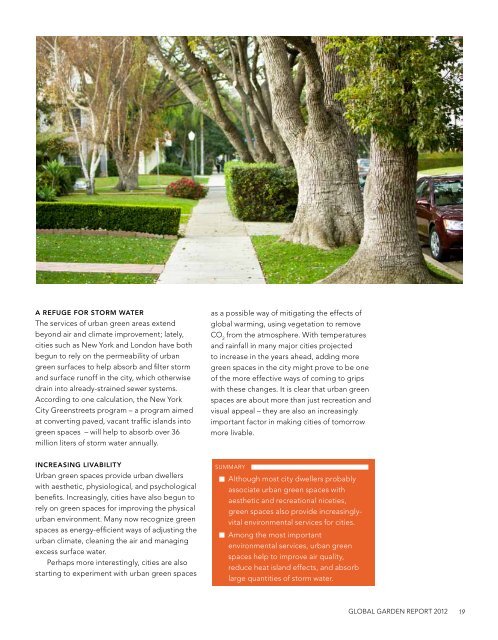GLOBAL GARDEN REPORT 2012 - Husqvarna Group
GLOBAL GARDEN REPORT 2012 - Husqvarna Group
GLOBAL GARDEN REPORT 2012 - Husqvarna Group
Create successful ePaper yourself
Turn your PDF publications into a flip-book with our unique Google optimized e-Paper software.
A REFUGE FOR STORM WATER<br />
The services of urban green areas extend<br />
beyond air and climate improvement; lately,<br />
cities such as New York and London have both<br />
begun to rely on the permeability of urban<br />
green surfaces to help absorb and filter storm<br />
and surface runoff in the city, which otherwise<br />
drain into already-strained sewer systems.<br />
According to one calculation, the New York<br />
City Greenstreets program – a program aimed<br />
at converting paved, vacant traffic islands into<br />
green spaces – will help to absorb over 36<br />
million liters of storm water annually.<br />
INCREASING LIVABILITY<br />
Urban green spaces provide urban dwellers<br />
with aesthetic, physiological, and psychological<br />
benefits. Increasingly, cities have also begun to<br />
rely on green spaces for improving the physical<br />
urban environment. Many now recognize green<br />
spaces as energy-efficient ways of adjusting the<br />
urban climate, cleaning the air and managing<br />
excess surface water.<br />
Perhaps more interestingly, cities are also<br />
starting to experiment with urban green spaces<br />
as a possible way of mitigating the effects of<br />
global warming, using vegetation to remove<br />
CO 2 from the atmosphere. With temperatures<br />
and rainfall in many major cities projected<br />
to increase in the years ahead, adding more<br />
green spaces in the city might prove to be one<br />
of the more effective ways of coming to grips<br />
with these changes. It is clear that urban green<br />
spaces are about more than just recreation and<br />
visual appeal – they are also an increasingly<br />
important factor in making cities of tomorrow<br />
more livable.<br />
SUMMARY<br />
Although most city dwellers probably<br />
associate urban green spaces with<br />
aesthetic and recreational niceties,<br />
green spaces also provide increasinglyvital<br />
environmental services for cities.<br />
Among the most important<br />
environmental services, urban green<br />
spaces help to improve air quality,<br />
reduce heat island effects, and absorb<br />
large quantities of storm water.<br />
<strong>GLOBAL</strong> <strong>GARDEN</strong> <strong>REPORT</strong> <strong>2012</strong><br />
19

















